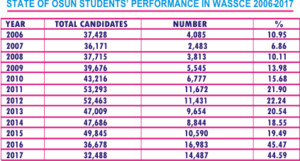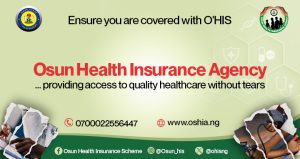Education
Quality And Politics Of Education In Osun By Kola Omotunde-Young

Quality And Politics Of Education
There have been a number of commentaries related to happenings in Osun early this year 2020, concerning education and these have focused on alleged reversal by Governor Oyetola, of some policies initiated by the previous government led by Aregbesola. These have ignored the fact that the reviewed policy issues are quite few compared to those adopted and being continuously implemented by the Governor.
Progress in life requires continuous review of situations and policies. However, rather than educate and edify, most of the commentaries have focused on the mundane and unimportant at the expense of the fundamental responsibilities of Government on education.
It is unfortunate the level to which we have sunk. If you read these contributions, you are more likely to think the most important contributions to education in Osun by the government led by Aregbesola, in which Governor Oyetola was the Chief of Staff, were, (i) restructuring of schools into Elementary, Middle and High schools, (ii) Unification of school uniforms of government-owned schools and (iii) The renaming of government-owned schools; in that or any order.
By statistics provided by the West African Examinations Council (WAEC), which can be independently verified by anyone, the best performance in West African Senior School Certificate Examination (WASSCE) in Osun during the tenure of the Government which Aregbesola took over from, was 15.68% for credit passes and above in English, Mathematics and five other subjects (and this was in year 2010).
The implication of this was that out of 43,216 (Forty three thousand two hundred and sixteen) pupils presented by that Government only 6,777 (Six thousand, seven hundred and seventy seven) pupils had credit passes and above in 5 subjects including English and Mathematics. So in the best year of that government, 36,439 (Thirty six thousand, four hundred and thirty nine) pupils in Osun out of 43,216 (Forty three thousand two hundred and sixteen) could NOT matriculate!!!.
To verify this, do not recoil into the shell of rumour mongering and unsubstantiated facts from search engines, please crosscheck it independently from WAEC or you may also ask the National Bureau of Statistics (NBS) to furnish you that information.
For most of our rulers – many certainly are not leaders – and many of our (improperly) educated elites who unfortunately have access to mass media as opinion writers and influencers, there was (and still is) nothing unusual about this, otherwise all hell should have broken loose.
For an Aregbesola, with the conscience, leadership values, passion and commitment with which he threw himself at the assignment, it was UNIMAGINABLE CHAOS.
Aregbesola’s underlining policy on education was to solve the problems of the quality of education, whatever it took and not the problems of the politics of education.

After consulting with various stakeholders in education through its education summit, the State Government of Osun adopted an education policy that was deliberate, bold, comprehensive and holistic in its response to a scandalous education rot.
Interventions on education by the government led by Aregbesola produced a result in 2018 which was 40.85% for 5 credit passes and above in 5 subjects including English and Mathematics – certainly not good enough yet, but not in the same league as 15.68% in 2010 that he met. In this same WASSCE of same year 2018, 70.73% of Osun pupils had Credit or A grades in Mathematics, 61.90%had Credit or A grades in Further Mathematics, 53.56% had credits or A grades in English Language, 75.22% had Credit or A grades in Physics, 59.28% had Credit or A grades in Biology and 54.44% had Credit or A grades in Chemistry. 79.03%had Credit or A grades in Agricultural Science, 68.49% had Credit or A grades in Economics, 69.76% had Credit or A gradesin Financial Accounting, 61.31% had Credit or A grades in Commerce, 62.89% had Credit or A grades in Bookkeeping, 61.73% had Credit or A grades in Marketing. 63.86% had Credit or A grades in History, 52.31% had Credit or A grades in Geography, 61.66% had Credit or A grades in Government, 69.85% had Credit or A grades in Tourism, 67.26% had Credit or A grades in Yoruba. In fact in all main subjects important for educational progress, more than 50% of Osun pupils had Credit or A grades in 2018 when the government completed its term of eight years.
These are feats that did not happen before the interventions. Even the result of pupils with credits in 5 subjects that include English and Mathematics together – which he regarded as work-in-progress for his successor to complete – was 260.52%, which is almost three times better than the results that the government Aregbesola took over from ever produced.
What this means is that if such a leap as achieved with policies introduced by the government led by Aregbesola is sustained, Osun could say goodbye to less than 80% performance in WASSCE for ever.
To understand and appreciate the depth of these interventions, Master Akintade Abdullahi Akanbi, the pupil who won the 1st prize in the year 2020 Young Nigerian Scientists Presidential Award Competition, is a final year pupil in one of the world-class model schools newly built during Aregbesola’s tenure, so that the children of the ordinary citizens of Osun could have world-class education. The young boy acknowledged and credited the quality of the facility and teaching in the school for contributing to his success.
That is the dividend of a focus on solving the problem of quality of education, whatever it took; this is the most important policy.
You only need to drive through or visit Osun and you would see schools built with facilities that compare with schools you see in Europe and USA (and this is no exaggeration) with toilet facilities and running water to ensure that not only are they aesthetically attractive to encourage pupils to desire to attend and stay in schools, they are also hygienic.
The Government led by Chief Bisi Akande built schools and ensured they provided water and toilet facilities to make the schools usable. The Government that came after him did not seem to have appreciated the importance of toilet facilities in schools and how this could make a difference in the quality of teaching and learning, so they built classroom blocks – many of which are currently unusable – and didn’t usually remember to provide toilets.
Government led by Aregbesola delivered 3,685 new classrooms, 127 new model and renovated schools, 62,922 pieces of new furniture, added toilets to 160 schools and provided 45 school buses.
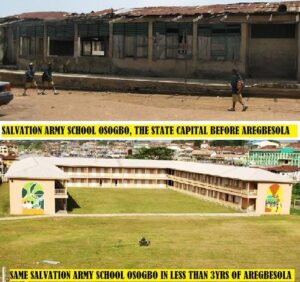
Of course, world-class infrastructure alone does not deliver world-class quality education. To resolve this, the Government established Omoluabi Education Services Limited (OESL) to manage and supervise the eleven (11) Model High Schools, each with capacity for 3000 pupils, being built across the State to take advantage of the natural urbanised nature of Yoruba settlements and provide world-class infrastructure.
The Vision for OESL was to run the High schools sustainably, as world-class schools with some independence from the government. OESL was to coordinate the running of the world-class High schools and ensure they produce confident, matriculate-able students who are first class scholars, cultural icons and models of good character, innovation and competence; the true Omoluabi.
Government’s role in OESL was to be limited to its membership of the Board. Being a wholly owned company of the State Government, it was subject to the Parastatals Monitoring Unit of the Governor’s Office.
Government engaged the services of African Management Services Company (AMSCO) – a pan-African organisation that provides integrated human capital development solutions to private and public sectors across sub-Saharan Africa. AMSCO was established to manage the African Training and Management Services (ATMS) project of the United Nations Development Programme (UNDP), International Finance Corporation (IFC) and the African Development Bank (AfDB). For Osun, AMSCO helped to recruit, second and manage for OESL, a Chief Executive Officer (CEO) with extensive world-class education and management experience from different countries.
The Government also engaged Phillips Consulting in Lagos to help engage Education Administrators with local and International Private schools’ experience in Nigeria to administer each of the schools under OESL These Administrators started the running of Osogbo Government High School, Ataoja Government High School, Osogbo, Wole Soyinka Government High School, Ejigbo and Seventh Day Adventist Government High School, Ede which were the first schools to be ready. The Administrators worked with experienced, dedicated, public school Principals and Teachers in managing the schools to world-class standards while training and coaching the Principals and Teachers to be able to take over from them.
Similarly, government approached and got the consent of Obafemi Awolowo University (OAU), Ile-Ife to take responsibility for the administration of Oduduwa Government College Ile-Ife and also Osun State University to administer Ilesa Government High School and Fakunle-Unity Government High School, Osogbo that had just been completed.
These efforts of government have produced truly world-class schools that will be appreciated when one embarks on Education Tourism to Osun. In truth some Development Agencies like UNICEF actually brought representatives of other State governments to Osun so they could see what Osun did in education within eight years only.
You may wish to visit Osogbo Government High School, from where Master Akintade Abdullahi Akanbi, the pupil who won the 1st prize in the year 2020 Young Nigerian Scientists Presidential Award Competition was trained. It was also not a surprise that many of the high scores in the Unified Tertiary Matriculation Examination (UTME) in Osun in the year 2018 were from Osun public schools.
Seeing the difference in outcomes, isn’t it much more beneficial if the commentaries are more on suggestions to ensure that the world-class facilities developed to support learning outcomes, are well maintained and more of these are provided?
O-Meals, the school feeding programme was developed to ensure pupils in the first four years of elementary school have the right nutritional intake to support development of their brains. Studies by UNICEF and top scholars in the world have shown that the state of health at early years of the child’s life affect permanently the development of the brain. To some of the pupils, the meals served in school, was the most nutritionally beneficial meal they ate every day.
The innovation brought into the scheme, earned the government world acclaim, leading to studies by Universities in Europe and America. The Osun Government was invited to address the UK parliament, South Africa and all over the world to share experience. The programme designed in Osun, was adopted by the Federal Government and many of the states in Nigeria.
Enrolment in Elementary schools increased from 155,318 to 252,793 as a result of the introduction of O-Meal; an increase by 62.8%. O-Meal programme served more than 300 million plates of food between 2012 and 2018. It engaged and empowered 3,007 female food vendors, 900 Cocoyam farmers, 700 small poultry farmers, 310 catfish farmers etc.
Since many of the commentators and so-called elites do not have children in public schools, they do not appreciate that a very large percentage of the children in public primary schools are underfed and undernourished, not by their own choice, but by involuntarily being born to families with very lean or no purse at all.
It will be beneficial when commentaries, analysis and synthesis on education include the linkage between poverty, hunger, lack of access to quality education and insurgencies like Boko Haram, banditry etc. scourging the nation, and how a programme like O-Meal can be sustained and improved in Osun and nationwide.
To ensure discipline and sustainability, parents, community leaders and all concerned were co-opted into management of schools by the setting up of the Community-Based School Management Committees (Boards, Councils etc.) for the schools. A unit called Education Marshal was set up and the duty of the Marshals was to keep off all school age children from the streets during school hours and ensure they are taken to schools. The Quality Assurance and Morality Enforcement Agency was also set up to focus attention on quality. These immediately improved discipline across schools in Osun.
Details of every pupil was also captured biometrically and assigned unique identifiers. This was to ensure every child could be uniquely identified, performance tracked and managed, using Education Management Information Systems (EMIS). Pupils were already being issued the Omoluabi Biometric Identity Cards by 2017.
These results could not have been possible without the investment in personnel. For the first time, Tutor Generals/ Permanent Secretaries and Head Master Generals/ Permanent Secretaries cadres were introduced to deepen management of education in Districts and Regions. These were elevated from amongst Principals of Secondary Schools (The 3 Tutor Generals/P.Ses) and Heads of Elementary Schools (The 9 Head Master Generals/P.Ses}.
Also for the first time, barriers limiting Teachers in Elementary Schools who are University Graduates to Salary grade level 14 was removed, so they could aspire up to grade level 16 like their counterparts in secondary schools.
More than 4,000 Teachers newly employed and 6,000 plus graduate members of the Osun Youth Empowerment Scheme with relevant qualifications were deployed to schools.
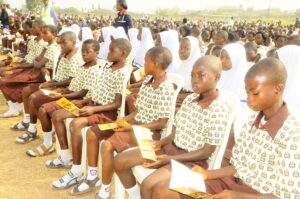
On capacity development for educators, records available show more than 30,145 Teachers and Administrators were trained. All true lovers of education should be interested in how to deepen some of these initiatives.
Still on quality, the tenure brought in innovations like training of thousands of Elementary School teachers on the use of Phonics in the teaching of languages. Skills of all Teachers of English Language and Mathematics were updated through training. A Unified Scheme of work was developed – first time ever in Osun – and distributed electronically to schools. Government approved Rural Teaching Allowances {RTA) and introduced Roving Teachers Schemes (RTS); all to ensure continuously improving quality in education.
For physical and intellectual development of pupils on discipline, coordination, planning and creativity, Calisthenics was introduced to pupils in Elementary and Middle schools. More than 29,000 pupils were trained and involved.
Thankfully, Opon Imo, the Tablet of Knowledge, another innovative idea birthed during the tenure of Aregbesola has received more praise and acclaim as an idea of the future in spite of the web of negative theories, a few tried to smear on it. Of course the implementation requires review and improvement to deliver more value and sustainability.
Our education in Nigeria – and most of Africa – is heavy on facts presented as knowledge, in the language and ways of our colonisers and at the expense of our language and culture. It is weak in critical and creative thinking, knowledge of African contributions to science and technology, virtue and nation building. It encourages consumption over productivity and glorifies certificates over talent and skills.
In recognising this weakness in our education, Obafemi Awolowo wrote in 1968 that “we must combat any educational scheme which tends to develop our bodies fairly well, our brains only partially, and tends to becloud our minds. For this is only a device for our permanent enslavement. But when our bodies, brains and minds are properly developed, we shall be free as individuals, and Nigeria herself will attain to national freedom”. Aliu Babatunde Fafunwa demonstrated successfully that teaching pupils using Yoruba language only to teach all subjects including science and mathematics (except other languages like English or French) in six years of elementary school produced better result than teaching them with a foreign language like English. He also got this adopted in the National Policy on Education.
To ensure that our children of the future grow up properly educated as true Omoluabi, creating solutions, working miracles as inventors – instead of seeking prosperity from miracles and rituals in religious houses -, Government led by Aregbesola took Awolowo’s advice. The government developed and adopted the Omoluabi Education Policy, with a mission to ensure that our educational institutions produce citizens who are true Omoluabi; cultural icons, virtuous, knowledge – seeking, critical thinking and problem – solving. Citizens who will actualise the vision of Sustainable prosperity in individual life and society.’
The change of School Uniforms was first and foremost a social safety response to the sorry state of the worn and torn School Uniforms that many of the pupils wore in government-owned schools in the year 2010. This was because their parents had been impoverished by bad governance. Government provided, free of charge, 750,000 new School Uniforms, designed and sewn to world-class standards. These helped immediately in lifting the image and the spirit of the child of the ordinary citizen.
The opportunity for goodness which the provisions of free School Uniforms represented also presented opportunity to reflate a depressed economy and elevate the skills sets of the people in cloth making. It was also an opportunity to create unique identity for government-owned schools. All these opportunities were seized with all hands.
It is unfortunate that many of the commentators on unification of School Uniforms in government-owned schools do not see the economic benefits and linkages that accrue, with mass production and merchandising of goods, for which market has been created through deliberate acts of government, as catalyst. Rather, focus has been on unsubstantiated claims of it affecting discipline negatively, when the real statistics on the ground about discipline in schools, before the policy and after does not support that view.
Beyond the name change, the Reclassification of schools into Elementary, Middle and High Schools does not in any way differ from the National Education Policy. Our National Education Policy specifies One Year Early Child Education, 9 years of Universal Basic Education (UBE) and 3 years of High School Education. There is no valid certificate in our system in Nigeria any longer for 6 –Year Education since the UBE law was passed.
By law, no child is permitted to be denied the minimum nine years of Basic Education schooling after which a Basic Education Certificate is issued. Also by legislation and policy every child must proceed to year 7 (JSS1) compulsorily and no child is to be discriminated against, prevented or allowed to drop out from proceeding to year 7 (JSS1) through qualifying examinations.
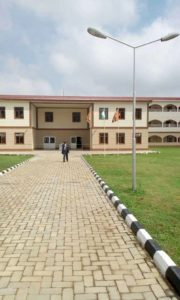
For administrative convenience of transitioning our previous system of 6 years Primary School and 5 years Secondary School, the Policy provides for 6 years Primary School, 3 years of Junior Secondary School and 3 years of Senior Secondary School or Technical College. Whether you have your school as a single 9-year Basic Education School, or break it down into 6-year Primary School and 3-year Junior Secondary School, or the 4-year Elementary School and 5-year Middle School, as the government led by Aregbesola did, the only valid certificate of schooling is the one issued after the 9-th year Basic Education Certificate Examination (BECE).
By the UBE law, Junior Secondary Schools are to have separate physical structures, assets and management from the Senior Secondary Schools. This is because Junior Secondary Schools are part of the Universal Basic Education and their costs are covered by the Federal Government through the Universal Basic Education Commission (UBEC), while the Senior Secondary Schools are exclusively the responsibility of State Governments.
Osun was not running the Basic Education System as required by the Policy and the UBE law before the government led by Aregbesola. Osun ran the Junior Secondary Schools (JSS) and Senior Secondary Schools (SSS) under the same assets, structures and management inappropriately, because of the reluctance – or may be ignorance – to embrace change from the old order.
So why did the government led by Aregbesola not just break into 6-3-3, rather than change what was supposedly working completely?
The truth was that it was not working, but no one was measuring the output. If it was working it would not have delivered 15.68% in WASSCE in year 2010 as the best result during the previous government. The Primary Schools were sending into the Secondary Schools, pupils with poor literacy and numeracy skills and poor understanding of basic scientific concepts.
In developed economies, you require very good first degree from a good university and still require to pass in the qualifying examinations before you can qualify to train as a Teacher. This is to ensure that the brightest and best teach in their schools and even more particularly, in the Primary (or Elementary) Schools. Teachers working in Primary Schools are expected to teach most of the subjects to pupils in their classes and so need all-round competence in various subjects.
In Nigeria, as currently structured, it is mainly the holders of National Certificate of Education (NCE), that teach in our government Primary Schools. Meanwhile we all know that for several years the requirements for admission into NCE programmes is the lowest either in WASSCE or UTME when compared to admission requirements for Universities and Polytechnics.
What our pupils require to learn by the time they get to Primary 5 and 6 in Quantitative and Verbal Aptitude, Mathematics, Introductory Sciences and Technology, are generally beyond the capacity of many Teachers holding NCE certificates only.
However in Secondary Schools, minimum requirements by the National Policy on Education are University Graduate Teachers who are specialists in core subjects like English Language, Mathematics, Physics, Biology, Geography, Economics, Basic Science, Basic Technology etc. that they are expected to teach.
The immediate effective solution to provide quality education at Primaries 5 and 6, for the government led by Aregbesola, was to move the pupils at those levels to the Middle (JSS) Schools where the Teachers are specialised in the subjects they teach.
Another important consideration that supported moving the pupils in years 5 and 6 to the Middle School was that the school feeding programme which was initially designed for years 1-3 pupils could have a backlash – which many others have not considered.
How will pupils in grades 4, 5, 6 react psychologically and in the long term, to the situation where everyday, their younger colleagues in years, 1,2 and 3 are fed nutritious meals within the same premises by the State, while they may be hungry?

The response of the government led by Aregbesola to this was to extend the school feeding programme to year 4 – and Osun was the only State and may still be the only one, feeding pupils in year 4 – and move the year 5 and 6 to Middle schools, such that there would not be pupils in same school hungrily watching their younger colleagues being fed, or pupils refusing to be promoted from one class to the higher class because of school meals.
I have not read how to resolve any of these two issues in all the commentaries on reclassification. I have read discussions about school reports to track school performance but once every child is captured biometrically with unique identity as discussed earlier, all it required to track the progress of the child, whether in an Elementary (Primary) or Junior Secondary (Middle School), or the parents change location and town, is robust Educational Management Information System (EMIS) which was provided.
To deepen and document its programmes for continuity in government policies, the government led by Aregbesola, with the support of International Development Agencies, developed the State Development Plan which included its Education Development Plan. It also concluded and adopted the Omoluabi Policy on Education. All these were done as part of its contribution to delivering education that guarantee Sustainable Prosperity in Individual Life and Society.
Aregbesola-led government was focused on the quality of education given to the child of the ordinary citizen and his/her learning outcomes while many of his critics – and they can be quite loud – have been focused on uniforms, restructuring and names.
Most critics neither have their children nor grandchildren in any of these schools and for many, their only relationship with the schools is that they once attended the schools and for that reason their words must prevail.
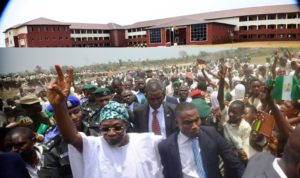
Governor State of Osun, Ogbeni Rauf Aregbesola rejoicing with
students, during the Students Official resumption and ommencement of
learning Osun New High Schools (Ataoja Government High School in Osogbo,
Wole Soyinka Government High School in Ejigbo, Adventist Government High
School in Ede and Osogbo Government High School, Osogbo), on Tuesday
21-03-2017
As credit to the ordinary citizens that Aregbesola sought to serve, the provision and unification of school uniforms, restructuring into Elementary, Middle and High Schools, and the renaming of schools were all concluded by 2013 and even though the noise and conspiracy from these self-appointed critical elites were strident against him, the people showed their appreciation by returning him for a second term in 2014, with more than two thirds of the votes cast in the state for his re-election.
Kolawole Wasiu Omotunde-Young is the immediate former Commissioner for Education in Osun State.
-

 News3 days ago
News3 days agoAPC National Chairman: Moves To Oust Ganduje Put Presidency In Quandary
-
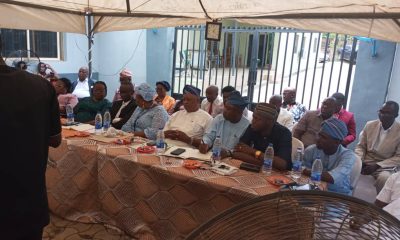
 News2 days ago
News2 days agoOsun RAAMP Opens Bid For Road Constructions Statewide
-
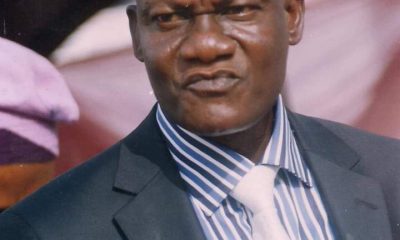
 News4 days ago
News4 days agoComrade Joseph Sangosanya dies at 67
-
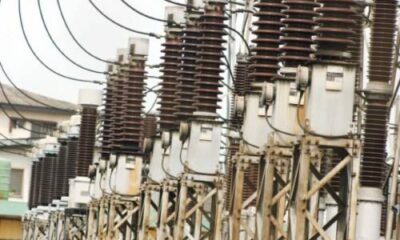
 Opinion2 days ago
Opinion2 days agoRegulatory Commission Must Wakeup From Slumber To Rescue EKEDC From The Shackles Of Dere Otubu By ADAPHAI


